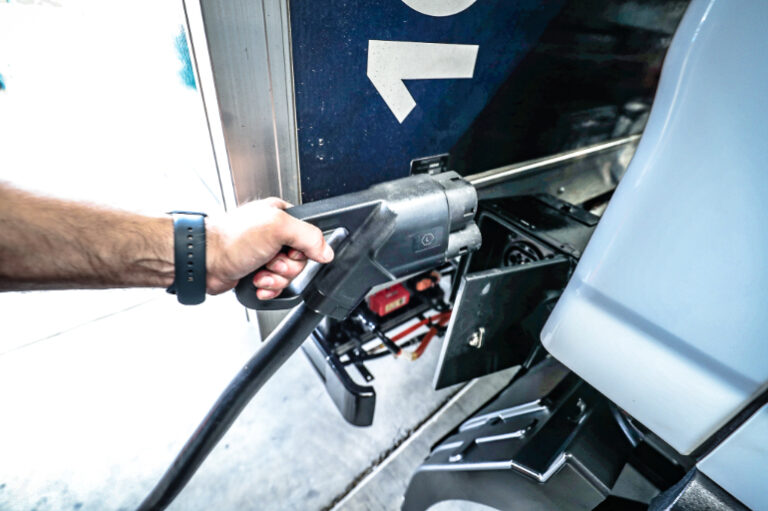Zenobe Energy’s Country Director EV for Australia and New Zealand, Gareth Ridge, took the stage at the 2025 Smart Energy Council Expo in April to share insights on how battery-backed charging hubs can help overcome key barriers to the electrification of truck fleets.
For Fleet Managers, Sustainability Managers and Finance Managers wrestling with the complexities of transitioning to electric heavy vehicles, Ridge’s presentation offered practical lessons from Zenobe’s international experience—and a clear-eyed assessment of the local market challenges.
Zenobe is a specialist in battery-based infrastructure. Globally, the company owns and operates more than 700 megawatts of large-scale batteries connected to transmission networks, and it is now bringing that expertise to the charging ecosystem for electric trucks.
“Our business is about owning and operating battery assets, both on the grid and behind the meter,” said Ridge. “We also focus heavily on second-life batteries, and have been repurposing old bus batteries into second-life storage solutions for five years now.”
The case for battery-backed truck charging hubs
One of the standout projects Ridge highlighted was a UK-based truck charging hub designed to mitigate high energy costs and connection constraints—two of the most pressing challenges facing Australian truck fleets considering electrification.
“We provided battery storage at this site to manage and reduce peak demand charges,” he explained. “We’ve also used software to plan the charging infrastructure and align it with the actual operational needs of the trucks running out of that site.”
The hub combines smart charging with onsite battery storage to enable what Ridge described as “off-site charging”models. This is particularly important for operators where space, rental costs and connection constraints make depot electrification difficult.
“Increasingly, constraints on electrifying everything at a depot—both space and cost—are becoming more significant issues,” Ridge said. “That’s driving interest in off-site hubs.”
Bridging the TCO gap
For Finance Managers, Ridge was candid about the current economics of heavy vehicle electrification.
“We wouldn’t be in this business if the capital didn’t make sense,” Ridge said in response to an audience question about business cases for EV truck charging. “Our longest contracts are 20 years. We’re seeing that the total cost of ownership (TCO) gap is getting very close to parity with diesel, particularly when you consider rising fuel prices and declining battery costs.”
However, a critical challenge remains the mismatch between short-term freight contracts and the long-term investment required for EV infrastructure.
“Customers often have two- or three-year transport contracts, but we’re investing in assets with 15 to 25-year lives,” Ridge noted. “We need to find ways to align contract terms with infrastructure investment to make these projects bankable.”
Smarter charging and grid integration
Ridge also addressed a key operational issue for Fleet Managers—how to optimise EV charging.
Zenobe’s hubs deploy smart charging strategies that balance the grid load and truck charging schedules.
“This is about throttling chargers down to the rate that’s actually needed—rather than charging at maximum speed unnecessarily,” Ridge explained. “For fleets where trucks are parked for extended periods, there’s no value in a fast charge. Managed charging saves both money and grid stress.”
Another benefit of onsite batteries is the ability to provide grid services—using stored energy to participate in frequency control markets or reduce site energy costs.
“We see a big opportunity here,” Ridge said. “If we can aggregate even 2% of the fleet to participate in these services, there’s going to be a lot of additional value created.”
Supporting fleet operators of all sizes
Looking ahead, Ridge sees potential in extending Zenobe’s model beyond large, purpose-built hubs.
“We’re exploring how to support smaller operators who don’t own depots,” he said. “Home charging for truck drivers is a big barrier—there are hundreds of thousands of drivers who take trucks home at night. We’re working on ways to provide safe, affordable home charging solutions for them.”
Zenobe is also helping property owners and landlords of warehouses and logistics facilities understand how to electrify their sites in collaboration with transport operators.
The takeaway for Australian fleets
Ridge’s message was clear: while truck electrification is progressing fast globally, Australian fleets will need flexible infrastructure models to match the realities of local contracts, depots, and power networks.
Battery-backed charging hubs can provide the flexibility and grid resilience required to make large-scale electrification viable.
For Fleet Managers and Sustainability Managers planning medium- and long-term transitions, Ridge offered a pragmatic outlook: “Work closely with your property partners, understand your charging needs, and look at batteries as part of the solution—not just for grid backup, but as a key enabler of smart, cost-effective truck charging.”






